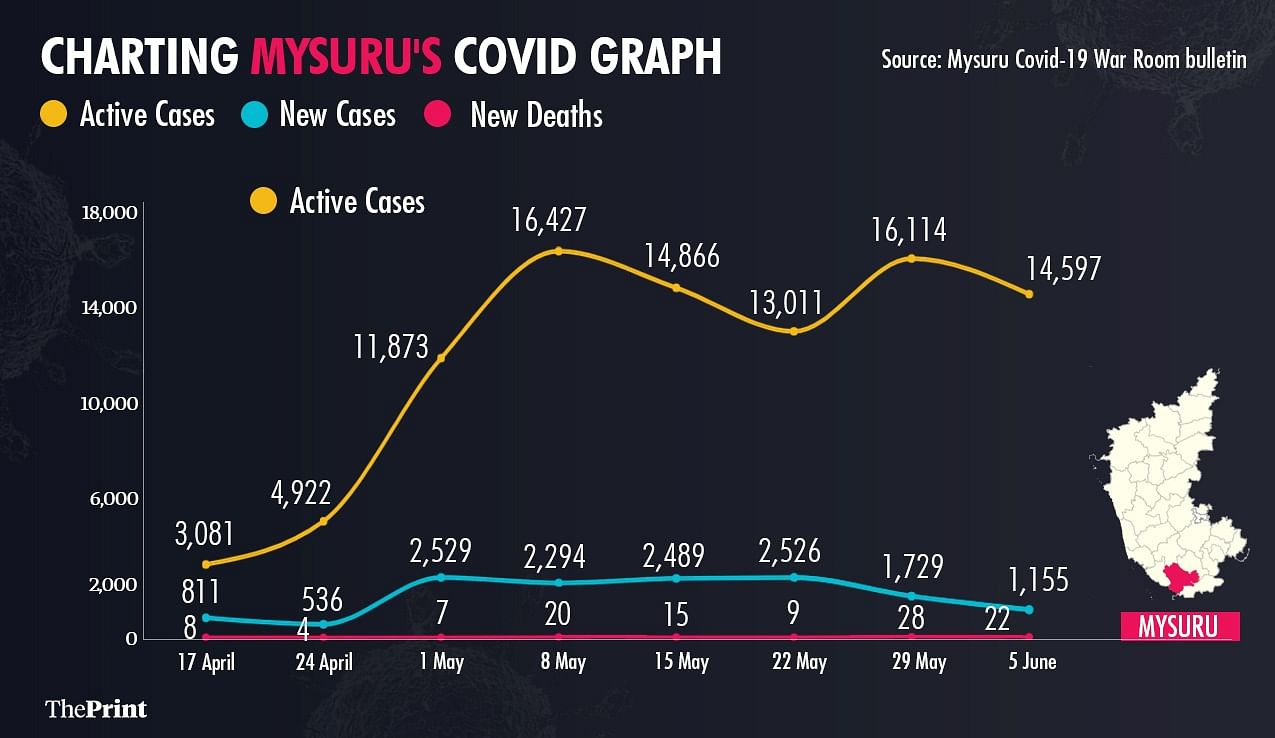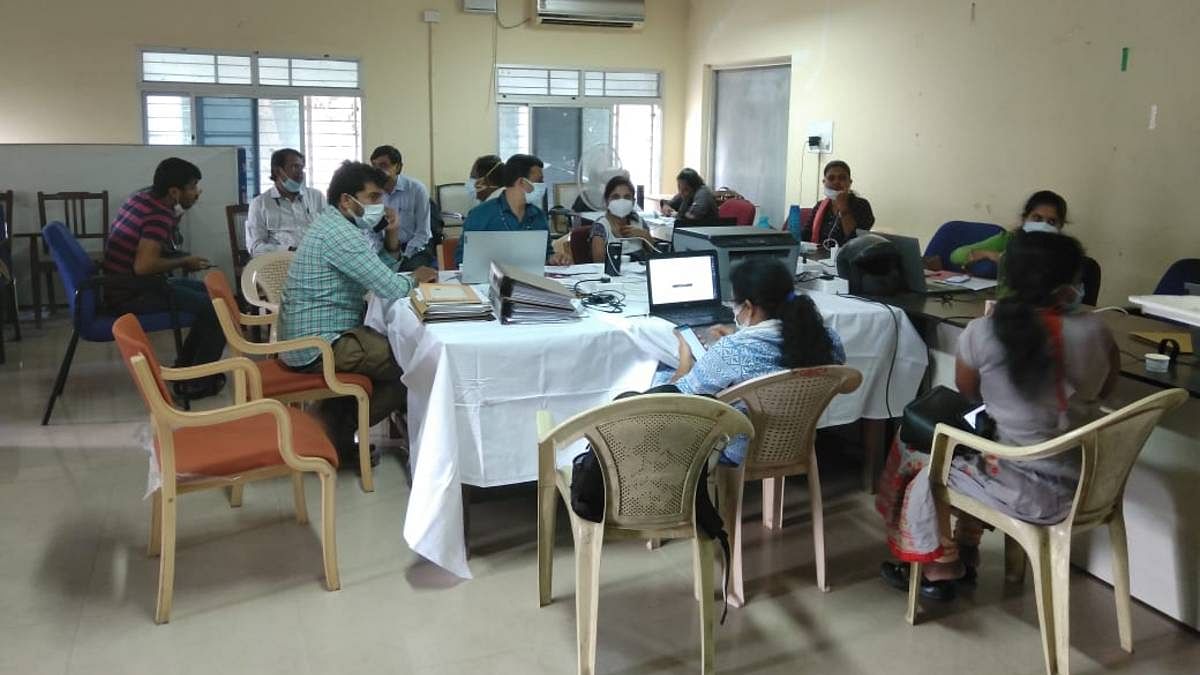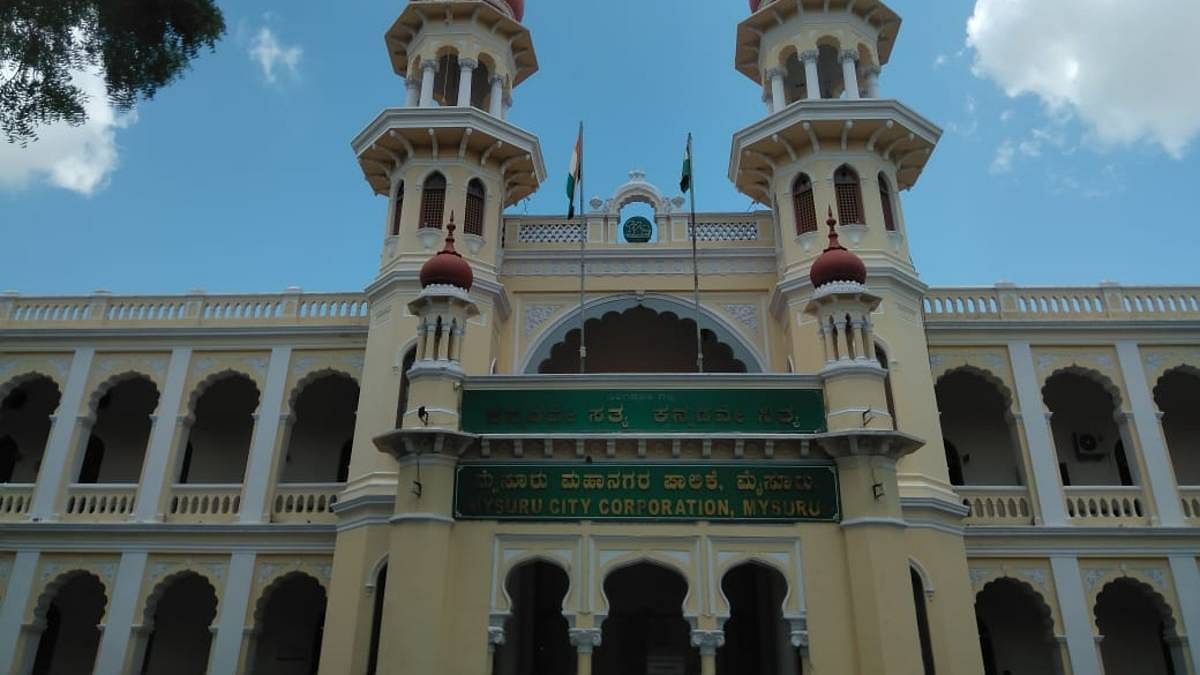Mysuru: In the past fortnight, Karnataka’s Mysuru has been in the news following a public spat between former deputy commissioner Rohini Sindhuri and former city corporation commissioner Shilpa Nag, who were both subsequently transferred.
The conflict hit a crescendo earlier this month when Nag tendered her resignation, accusing Sindhuri of “targetting” her. Meanwhile, Sindhuri, countered the claim with a list of allegations criticising the corporation’s Covid management.
Mysuru’s Covid troubles, however, date further back than the differences between these two. In April, even as Bengaluru was leading the state in Covid count, Mysuru had emerged as a major hotspot. The number of Covid cases here saw a drastic spurt by the end of April, as the tally/day rose to over 1,500, according to the daily reports issued by the Mysuru District Covid-19 War Room. In the last week of May, the reports showed, the district reported between 1,500 and 2,000 cases daily.
Among the eleven taluks in the district, Mysuru city has reported the highest number of cases, with the tally rising to over 1,000 between 1 and 27 May, according to the war room reports. The number of cases in the city started dipping only on 28 May.

When ThePrint visited the district last week, officials in the civic administration said there were of a number of factors contributing to the spurt in cases here — non-compliance of the lockdown announced by the state government across districts in April and Covid protocol, as well as a fall in the number of tests being conducted, which led to a higher positivity rate (number of cases were increasing, but fewer tests were being done).
Also read: The Mysuru City Corporation office | Angana Chakrabarti | ThePrint
A lockdown?
As the number of cases began to rise in the state in April, the Karnataka government imposed a lockdown across districts.
But, according to a source in the Mysuru City Corporation (MCC), unlike during the lockdown last year, this time, police couldn’t check people from coming out.
“For instance, in the NR Mohalla (an area in Mysuru with a high density of slums), there is only one police station for a population of about 1 lakh people. How could they have controlled so many people? It was also very difficult to maintain the restrictions this time as the lockdown came during Ramzan.”
According to the official, 15 days into the lockdown, additional police personnel had to be called in to the district to control the situation.

Sources added that the people in the district too had not been following Covid protocols such as social distancing either. Many blamed the carelessness of the people for the spike in the number of cases.
As the situation deteriorated, the district administration under then-deputy commissioner Rohini Sindhuri put in place stricter restrictions till 7 June. When ThePrint visited Mysuru, the full-fledged lockdown was in effect, and except for police and a few vehicles, nothing could be seen on the roads.
All services except medical services, milk booths, vegetable and fruits stores, and fair price shops had been closed and even shops selling these essential commodities were allowed to open for only a few hours twice a week.
Also read: The young are driving Mandya’s 2nd Covid wave — 45% of its cases are in 21-40 age group
And the administration struggled…
Meanwhile, even as the district struggled to cope with the spurt in the number of cases, a conflict was brewing between the two top officials helming pandemic management in Mysuru.
Rohini Sindhuri, the former deputy commissioner, and Shilpa Nag, the former MCC commissioner, both blamed each other for not being able to handle the Covid situation. Among the accusations Sindhuri had made was the fact that the corporation had failed to set up Covid care centres (CCCs) in the district until recently.
The corporation official quoted above admitted that the process of setting up CCCs had been delayed. “In NR Mohalla’s Beedi Workers Hospital, for instance, it took us a month to set up the CCC because there was only one hospital and even that did not have proper facilities, such as enough doctors,” the official said.
The 200-bed CCC at the Farooqia College in the city was also only recently opened, the official added.

Another corporation official, who had been close to Nag, said the two war rooms set up by the district administration to monitor vaccinations and the availability of hospital beds, cases etc, were also not functioning properly. “The war rooms were never monitored or reviewed, and their capacities were not built upon,” he said.
Additionally, as ThePrint had earlier reported, although the district-level Covid-19 bulletin had reported 470 deaths in May, MCC Statistical Officer Anil Christie, in-charge of disposing of Covid-19 bodies, said the number in the city alone had been 1,003.
Despite these shortcomings, officials ThePrint spoke to said both Sindhuri and Nag had individually worked hard to manage the Covid situation in the district, setting up triage centres (where patients can walk in, and be examined, and their line of treatment be decided upon) and systems like the ‘Pancha Sutra’ (a five-point action plan to boost self-reporting of cases).
Meanwhile, the state government halved the testing target to 3,500 tests a day around the middle of May, which is likely to have increased the positivity rate in the district. The test positivity rate (TPR) indicates the number of positive cases for every 100 tests conducted. A higher TPR indicates wider transmission and the need to conduct more tests.
Around the time that the number of tests was reduced, positivity in Mysuru had crossed 55 per cent.
District Surveillance Officer Dr S. Chidambara, however, pointed out that “targeting” of symptomatic people had been the “need of the hour” at the time. He said, “We need to consider our lab capacity, we need to consider at what time we’re giving the results and the effect of the result on treatment.”
According to him, testing has now been ramped up and the district is conducting over 7,000 tests in a day, even as the positivity has dipped to below 20 per cent.
Mysuru has also been leading the state in terms of Covid-19 vaccination coverage.
(Edited by Poulomi Banerjee)
Also read: Karnataka to probe various sources of mucormycosis, including steroid overuse






